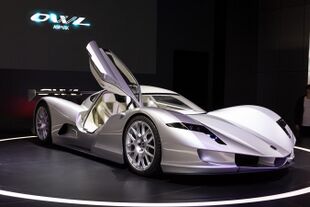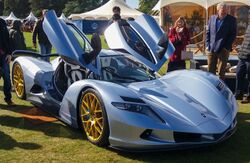Engineering:Aspark Owl
| Aspark Owl | |
|---|---|
 Aspark Owl concept at the 2017 IAA | |
| Overview | |
| Manufacturer |
|
| Production | 2017 (Concept) 2019 (Prototype) 2020–present; (Production) |
| Body and chassis | |
| Class | Sports car (S) |
| Body style | 2-door coupé |
| Layout | Double motor, all-wheel drive |
| Doors | Dihedral |
| Powertrain | |
| Electric motor | 4 electric motors (two rear, two front) |
| Power output | 2,012 PS (1,480 kW; 1,984 hp) 2,000 N⋅m (1,475 lb⋅ft) |
| Battery | 69 kWh (248 MJ) lithium-ion |
| Electric range | 451 km (280 mi)[1] |
| Dimensions | |
| Length | 4,830 mm (190.2 in) |
| Width | 1,935 mm (76.2 in) |
| Height | 39.0 in (990 mm) |
| uk|uk|Kerb|Curb}} weight | 1,900 kg (4,189 lb) |
The Aspark Owl (Japanese: アスパーク・アウル) is an all-electric battery-powered sports car manufactured by Japanese engineering firm Aspark (アスパーク), under development since 2018, with the goal of making the fastest accelerating electric car. It will be built by Manifattura Automobili Torino (MAT) in Italy. Aspark plans a production run of 50 vehicles, with a list price of €2.5 million. The Owl was publicly unveiled in concept form at the 2017 Frankfurt Auto Show,[2][3][4][5] and the production version was unveiled in November 2019 at the Dubai International Motor Show.[6]
Specifications and performance
The Owl has carbon fibre body work built around a carbon fibre monocoque chassis weighing 120 kg (265 lb). A stainless steel support structure is incorporated in the roof to increase the bodywork's strength. Changes to the bodywork from the concept include the addition of wing mirrors, an active rear wing and a redesigned rear glass. The car features double wishbone suspension with hydraulic dampers and torque vectoring for improved handling. Stopping power is handled by a carbon-ceramic braking system with 10-piston front calipers and 4-piston rear calipers.[6]
It has been claimed that the Owl can accelerate from 0-97 km/h (60 mph) in 1.72 seconds, 0-100 km/h (62 mph) in 1.9 seconds, 0-299 km/h (186 mph) in 10.6 seconds, and can attain a top speed of 418.429 km/h (260 mph), which would make it the fastest accelerating production car in the world. The car is claimed to have a range of approximately 250 miles and is said to take 40 minutes to fully charge.[7][8]
Gallery
See also
- Nio EP9
- Tesla Roadster (second generation)
- Rimac Concept One
- Rimac Nevera
- Deus Vayanne
- List of production cars by power output
References
- ↑ Bruce, Chris (12 November 2019). "Aspark Owl Debuts As 1,985-HP EV Hypercar, Hits 60 MPH in 1.69 Seconds". Motor1. https://www.motor1.com/news/381762/aspark-owl-production-model-confirmed/. Retrieved 13 November 2019.
- ↑ Anthony Cuthbertson (21 February 2018). "Owl EV: Tesla Rival Is First to Achieve 0-60 MPH in Under Two Seconds". Newsweek. http://www.newsweek.com/tesla-rival-first-achieve-60-mph-under-two-seconds-814671.
- ↑ Bradley Brownell (18 February 2018). "Drop Everything, Japan's Aspark Owl Electric Hypercar Just Did 0-60 in 1.9 Seconds". Jalopnik. https://jalopnik.com/drop-everything-japans-aspark-owl-electric-hypercar-ju-1823109921.
- ↑ Dan Mihalascu (14 September 2017). "Aspark Owl might just be the fastest accelerating car you've never heard of". Drive Mag. https://drivemag.com/news/aspark-owl-might-just-be-the-fastest-accelerating-car-you-ve-never-heard-of.
- ↑ David Tracy (13 September 2017). "Japan's Mysterious Aspark Owl Electric Supercar Concept Promises Ridiculous Acceleration". Jalopnik. https://jalopnik.com/japans-mysterious-aspark-owl-electric-supercar-concept-1805662707.
- ↑ 6.0 6.1 Hyatt, Kyle (12 November 2019). "Aspark's electric Owl hypercar is finally ready to hatch after years of waiting". https://www.cnet.com/roadshow/news/2020-aspark-owl-electric-hypercar-production/. Retrieved 13 November 2019.
- ↑ Pattni, Vijay (12 November 2019). "The 2,012bhp Aspark Owl is the most powerful production hypercar". Top Gear. https://www.topgear.com/car-news/dubai-motor-show/2012bhp-aspark-owl-most-powerful-production-hypercar. Retrieved 13 November 2019.
- ↑ "Watch the Aspark Owl set new EV speed records, at nearly 200 mph" (in en-US). 2023-05-24. https://autos.yahoo.com/watch-aspark-owl-set-ev-214400606.html.
Further reading
- 株式会社アスパークR&D事業部 (Aspark R&D), 【PV】ASPARK owl on YouTube (September 2017)
- (in Japanese) GigaZine, アスパークOWLが市販車世界最速の0-100km/h2秒切りを達成(2018年2月11日:栃木) on YouTube (11 February 2018)
- (in ja) モンスターEV「アスパーク OWL(アウル)」が世界初の市販車0-100km/hで2秒切りを達成、暴力的な加速を見てきた. GIGAzine. 11 February 2018. https://gigazine.net/news/20180211-aspark-ev-project-3rd/.
External links
- Aspark EVs webpage: Home || 変わる「価値観」、変わらない「走る喜び」 ASPARK 電気自動車開発 プロジェクト
 |





